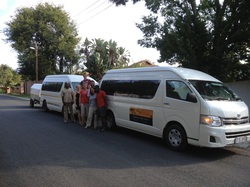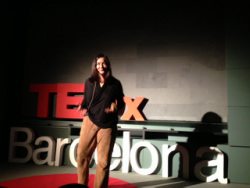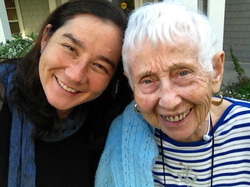
This post is one in a series of 5<5 posts that document pilot/prototype projects with the format 5 things that I wish someone had told me before I started in <5% of the time spent on the project.
Background
In March 2011, I ran a HubLab on "For Profit or Not-for-Profit" with Inder Comer, Esq. at HubSOMA. Intended for social entrepreneurs, the HubLab was also attended by lawyers, who often advised clients through this decision nexus. Intrigued by this "unexpected" participant group, I kickstarted a "pilot" of breakfast conversations. "Cereal conversations" gave legal practitioners at this nexus of law and enterprise for social impact a forum to discuss practice experiences and concerns. Social enterprise law is largely unchartered legal terrain- full of "open" legal issues, which means that a court has not yet 'ruled' to decide the "law" on many issues that are emerging from social innovation. Legal questions about liability and tax implications in the sharing economy, regulation of food production for microenterprise, employment status and compensation for passion equity, etc. Typically, good legal advice steers a client away from uncertainty in favor of what is known, what is certain, and what is "settled" in the law. Uncertainty is risky and potentially very expensive. However, until people- clients and lawyers- push the edges of "certainty" into these open, untested areas- the status quo in business will not change.
Cereal conversations brought practitioners together for peer learning and aimed to build a community of legal practitioners who want to push the edges of the law. Drawing on a model from clinical medicine where clinicians make decisions even amidst uncertain outcomes based upon a bioethical, principled justification, I opined that perhaps a similar values-driven approach to decision making could govern and guide legal practitioners, provided that the involved parties gave fully informed consent to the risks. My assumption was that if we built a community and developed a shared knowledge base, it would be sufficient to support legal practitioners ready to take this risky step to shift the status quo in how business operates. My hope was to identify the key 'ingredients' necessary to seed a local legal community pf practice, to design a DIY 'cookbook' that other communities could use to kickstart local chapters globally, and to build a 'recipe' braintrust to which local practice groups could contribute that would inspire innovation in legal practices at the intersection of business for social impact.
5 Things I Wish I Knew About Community Building Before I Started:
- 8am is too early for a meeting in San Francisco
- Building a community takes time. 5 times just gets things started.
- Meetings need to take place regularly. To get work done- weekly is effective, to build community- monthly is sufficient.
- Get a small group to share the organizing responsibility (2-3 is enough)
- For niche communities, keep the audience focused in order to maximize value to early participants. Here, it was more productive to have a majority of lawyers with only legally savvy strategy consultants, rather than a meeting with social entrepreneurs who seek information for their specific venture.
Ultimately, cereal conversations was a prototype of a potential model. It was a pilot test of assumptions. The Bay Area group was the inaugural "Lucky Charms" group who pioneered the (ad)venture. We learned a lot and we hope that the fruits of that learning shared here will strengthen the global community of legal practitioners active in this area.
Why did we do it?
- To develop a community of practice to strengthen practice in the legal grey areas of this sector.
- To develop a format that provided value to satisfy the depth needed by legal eagles and practicality for social entrepreneurs
- To strengthen the social enterprise community's access to new paradigm approaches by engaging the legal community in conversations with social entrepreneurs, impact investors and business consultants.
- To kickstart a grassroots community generated knowledge commons on these emerging legal issues.
- To create a forum for collaboration and knowledge sharing among legal practitioners
Methods
What did we do?
A breakfast club to "Map the Terrain" and build an initial community of legal practitioners. In this 5 week pilot, we met over cereal for conversations to map the legal landscape at the intersection of business and social impact. The topics that we covered included: the business judgment rule, new CA corporate forms, mapping issues, social enterprise partnerships, and alternative dispute resolution and conflict management in the socent sector.
Our short term aim was to have one concrete, practical project from each pilot. Proposed projects included:
- a model "founders/partnership agreement" for social entrepreneurs
- a map/quick guide to identify how/when social impact focus may generate new/different legal issues
- a tactical considerations guide for the varying corporate forms
- an article on the role of ADR in social enterprise
Our long term aim was two-fold:
1. To develop a cookbook "how to start a SocEntStrategy community of practice in __(your area)__"
2. To develop a grassroots, knowledge commons on these issues at the intersection of law, business and social impact
Our core commitment that all resources developed will be provided open access under a creative commons: attribution/non-commercial/share alike. Any revenue generated from this initiative would be reinvested in the initiative's educational mission.
Who participated?
An open invitation was made to colleagues in this sector. We were generously hosted by HubSOMA. The SocEntStrategy Founding Alliance included:
Kate Michi Ettinger, Chef Converger of Cereal Conversations
Natalia Thurston, Social Venture Law Group
Tony Lai, Law Gives
Inder Comar, Comar Law
Lina Constantinovici, President, Biomimicry Incubator
How?
Doors open 7:45 (security can take awhile)
8 - 9 Legal Eagles Hour
30 min: in depth on legal topic + case presentation
20 min: discussion
10 min: map discussion and networking
9 - 9:30 Law for SocEnts
15 min: legal topic presented for Social Entrepreneurs
15 min: discussion
Results
- Of open invitation to 10 people directly and 10 people indirectly, we had a founding group of 5 people.
- We met consistently for 5 weeks.
- We shared knowledge, practice experience and developed a shared understanding of open issues within the sector.
- We identified opportunities for collaboration within the group; those collaborations continue to manifest.
- We experimented with and learned about technology that could support the group's work.
- For details: Weekly Posts: Week 1, Week 2, Week 3, Week 4, Week 5 (currently in publication)
Learnings & Opportunities
- There is a need for a community of practice among legal practitioners in this area.
- The social enterprise ecosystem will benefit from having the legal community that serves it strengthened.
- Building a community of practice takes time. Consistency is critical.
- Critical mass generates movement. Self organization may be overrated.
- Engage one community at a time. Clarity of purpose helps to respond to the diverse needs of why people show up. If targeting lawyers, stick with lawyers to keep the focus on issues that yield value to attendees.
- Use the work products of the primary community to engage secondary communities.
- Choose technology that you can manage or have access to tech resources to administer the technology you want.
- 8am is too early for many people and does not accomodate the geographic diversity of SF Bay Area, where traffic prohibits participation by practitioners not in the specific location.
- Ideas take awhile to seed: People are ready now for an idea from 2 years ago that was prototyped 1 year ago.
- Business law and corporate structures are domestic/state law issues. This invites a creative glocal solution to building this grassroots community.
- The effort to bring Cereal Conversations to Berlin resulted in identifying of a different doorway into the legal issues: case studies of pioneering social enterprises. These case studies provide a simple framework through which to identify the open issues and to respond with how each could be addressed within one's jurisdiction. These "Cases" become a common ground of understanding between geographic regions governed by different laws. We are working to inspire the passion of the university students in law to explore social enterprise and business for social impact.
- The effort to bring Cereal Conversations to London/UK resulted in the idea of a legal "briefhack," by the brilliant Polina Hristova. The IDEA: One weekend at Hubs around the world. Gather local law students, attorneys and social entrepreneurs. Have students interview social entrepreneurs to identify legal issues at the edges. Students confer with social enterprise attorneys who review the cases collectively in a panel format. The law students then "brief" the legal issues raised by the social enterprises. The net result is law students have the "brief" as a work product to show future employers. The social entrepreneurs have an understanding of the issues they need to address. The attorneys deepen their practice around these open issues and contribute to building a the glocal knowledge base.
Long Term Outcomes
- Impact Law Forum, co-founded by Natalia Thurston of Social Venture Law Group and Zoe Hunton of Hunton Law, hosts a monthly meeting with speakers to strengthen the community of legal practitioners who work at the intersection of law and social enterprise. ILF rotates around the Bay Area.






 RSS Feed
RSS Feed